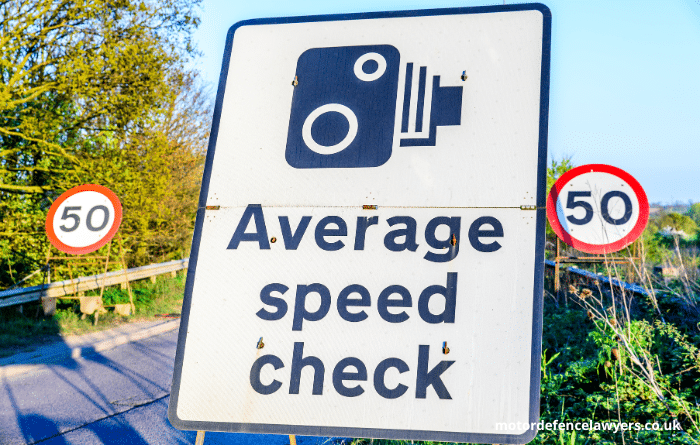Why Choose Us
- Ranked in the top 3 law firms by Trustpilot
- Nationwide Legal Coverage
- Free Consultation
- Fixed Fee Terms
- Competitive Rates
- Flexible Payment Plans
- Trusted Legal Care
- UK’s Leading Motoring Solicitors
5 out of 5
Our customers rate us
“EXCELLENT”
AS SEEN ON
02.10.2023
Are Temporary Speed Limits Enforceable?
Yes, temporary speed limits are enforceable, making it essential for drivers to pay attention to displayed speed limits and watch for repeater signs indicating any temporary limit or changes, even on familiar routes.
If you have missed a change in the speed limit when driving, then it is important that you keep an eye out for repeater signs indicating what the speed limit is. It is possible that there may be a temporary speed limit in force or that the speed limit has permanently changed recently, and you did not notice.
If you are facing a charge of speeding, whether in a temporary speed limit zone or otherwise, it’s important to seek expert legal advice. At Caddick Davies, we are experts when it comes to defending motoring offences.
Whether you’re hoping to have the conviction overturned or planning to go to court and plead guilty to the offence, we can prepare a strong case that gives you the best chance of minimising the penalties faced and getting a successful outcome in court.
Contact our team for a free consultation at 0151 944 4967.
Read on for an overview of mandatory and temporary speed limits and how they affect you on the roads.
Whilst temporary speed limit signs are enforceable, it’s important to note the difference between mandatory and temporary speed limit signs.
The most common sign that you will see in regards to speed limits is a circle white sign with a red border, with the speed limit displayed in bold black text in the centre.
Speed limits in the UK tend to be 20, 30, 40, 50 and 60 mph. If you see one of these signs, then you are prohibited from going above the limit displayed as it is a mandatory speed limit.
For example, if the sign displays 20mph, you can go 20mph but no higher. It is important to remember that a speed limit is a limit and not a target, and therefore you can and should go lower if the conditions are not suitable.
Another speed limit sign that you will see often is the national speed limit sign. This is a circle white sign with a diagonal black stripe from the top right to the bottom left. This sign indicates that the speed limit has changed to the national speed limit for the type of road that you are driving on. If you are driving on a single-track road the national speed limit is 60mph, but if you are driving on a dual carriageway or motorway the national motorway speed limit is 70mph.
Speed limits that use the above signage are mandatory. A motorist must abide by the instructions given to remain within the law. If you fail to do so, there is a risk that you will be charged with a speeding offence and have your licence endorsed with penalty points, and in more serious cases, a disqualification from driving.
A less common sign that you will see, but are still expected to follow, is a mandatory minimum speed limit. These are blue circle signs with a recommended minimum speed displayed in white. When the minimum speed limit has ended the same sign will appear with a diagonal red stripe from the top right to the bottom left.
These signs are technically mandatory but are not enforced as frequently by the police. The reason is that it is sometimes impossible to stick to a minimum speed limit. For example, if you are stuck in traffic it would be unfair to penalise you for not going above the minimum speed limit.
If you are suddenly presented with a dangerous situation or a hazard and must stop immediately, it would also be unfair to pursue a prosecution. The police generally exercise discretion for the minimum speed limit, and it is very rare that individuals are prosecuted.
One misconception is that there is a minimum speed limit on the motorway and surprisingly, there is not; however, drivers should be wary of smart motorway rules which may include restrictions on using lanes to overtake queuing traffic.
This does not mean that you may not be stopped by the police or charged with an offence of careless driving, inconsiderate driving, or even dangerous driving for driving too slow on the motorway.
A recommended speed limit will be displayed when a stretch of road is potentially hazardous. For example:
– A recent road traffic collision.
– Congestion of traffic.
– Road works.
– Traffic officers in vulnerable locations.
– Extreme weather conditions.
Such signs are not mandatory, and this is indicative of how they are displayed. They are not displayed within a red circle and are therefore not enforceable as the mandatory speed limit.
Recommended speed limit signs can often cause confusion and therefore it is important to acknowledge them and consider your surroundings whilst also not forgetting the mandatory speed limit for that road.
Even if a speed limit is not mandatory, the prevailing conditions may mean that it is suitable for you to follow what is recommended.

The most common misconception about variable/temporary speed limits is that they are not enforceable as the mandatory speed limit. This is not true. A variable/temporary speed limit is generally enforceable, provided that it is displayed within a red circle. These signs are generally displayed digitally, particularly on motorways, where variable speed limits are commonly used to manage traffic flow. However, if roadworks are being done then the sign will generally be displayed at the side of the road using ordinary signage.
The reason for a variable speed limit may be the same as a recommended speed limit – congestion of traffic, road works etc. It is therefore essential that you keep an eye out for the red circle around a digitally displayed speed limit so that you know what is mandatory and what isn’t.
Whatever the reason for the change in the mandatory speed limit, the speed limit you see displayed will always be enforceable, even if you do not believe that the speed limit is reasonable. For example, if a mandatory speed limit has been changed for road works but there are no ongoing roadworks when you are driving along that road, it is still enforceable.

The maximum or national speed limit can also vary depending upon the vehicle that you are driving.
The speed limits shown below apply to all single and dual carriageways with streetlights unless there are signs displaying otherwise:
| Vehicle | Restricted Road | Single Carriageway | Dual Carriageway | Motorway |
| Car | 30mph (20mph in Wales) | 60mph | 70mph | 70mph |
| Motorbike | 30mph (20mph in Wales) | 60mph | 70mph | 70mph |
| Car-derived vans | 30mph (20mph in Wales) | 60mph | 70mph | 70mph |
| Dual purpose vehicles | 30mph (20mph in Wales) | 60mph | 70mph | 70mph |
| Cars, motorcycles, car-derived vans, and dual-purpose vehicles when towing caravans or trailers | 30mph (20mph in Wales) | 50mph | 60mph | 60mph |
| Motorhomes or motor caravans (not more than 3.05 tonnes maximum unladen weight) | 30mph (20mph in Wales) | 60mph | 70mph | 70mph |
| Motorhomes or motor caravans (more than 3.05 tonnes maximum unladen weight) | 30mph (20mph in Wales) | 50mph | 60mph | 70mph |
| Buses, coaches, and minibuses (not more than 12 metres overall length) | 30mph (20mph in Wales) | 50mph | 60mph | 70mph |
| Buses, coaches, and minibuses (more than 12 metres overall length) | 30mph (20mph in Wales) | 50mph | 60mph | 60mph |
| Goods vehicles (not more than 7.5 tonnes maximum laden weight) | 30mph (20mph in Wales) | 50mph | 60mph | 70mph (60mph If articulated or towing a trailer) |
| Goods vehicles (more than 7.5 tonnes maximum laden weight) in England and Wales | 30mph (20mph in Wales) | 50mph | 60mph | 60mph |
| Goods vehicles (more than 7.5 tonnes maximum laden weight) in Scotland | 30mph (20mph in Wales) | 40mph | 50mph | 60mph |

Many individuals reference the “10% plus 2mph” law. This is not a law or a rule. Many police forces in the UK have guidelines with regard to prosecution for speeding offences, but they are not mandatory for them to follow. The police are within their rights to charge you for going just 1mph over the speed limit.
You may have to go to court for a speeding offence if you have grossly exceeded the speed limit or if you have accumulated 12 or more points. This is because you will become liable for a lengthy driving ban, and this can only be imposed by the Court.
Please read our article on how to avoid a driving ban for further information.
Generally, as long as you are not at risk of hitting 12 points and provided that the average speed of that you were going is not significantly above the limit, then you will either be offered a Conditional Offer of Fixed Penalty (3 points and £100 fine) or a national speed awareness course. A speed awareness course is discretionary for the police to offer and can only be done once within a 3-year period.
The Police do not need photographic evidence documenting that you broke the speed limit. For more information please refer to our article on photographic evidence and the first steps for a speeding offence
The one takeaway from this article should be that it is essential to remain vigilant at all times when driving because temporary speed limits are enforceable, just like mandatory ones. Drivers can often go to autopilot when they are driving in familiar areas and can forget to pay attention to their surroundings resulting in being caught speeding.
It is important to distinguish between a mandatory speed limit and a recommended speed limit. This can be done by looking out for the red circle, which will indicate that the speed limit is mandatory. Whilst recommended speed limits are not mandatory, the prevailing conditions may make it that it is the most appropriate option and it is important to be considerate for other road users.
Disqualification from driving is a serious consequence for individuals who have breached the rules of the road in significant ways and have posed a significant threat to the safety of themselves and others on the road. When facing disqualified it’s important to understand the duration of the ban, which will vary according to the severity and frequency of driving offences committed.
A motoring defence solicitor may be able to help you reduce the period of the ban or avoid disqualification entirely depending on your circumstances.
Contact our friendly team to discuss your case on 0151 944 4967.
Why Choose Us
We have been successfully representing clients in motoring courts nationwide
Contact us for a free consultation, our expert solicitors will be able to discuss your case and advise on legal options.
Birmingham
Bradford
Bristol
Carlisle
Cardiff
Chelmsford
Huddersfield
Hull
Manchester
Liverpool
Leeds
London
Newcastle
Norwich
Nottingham
Sheffield